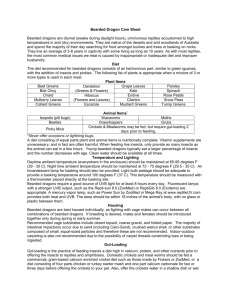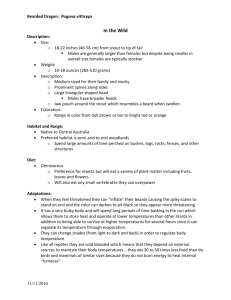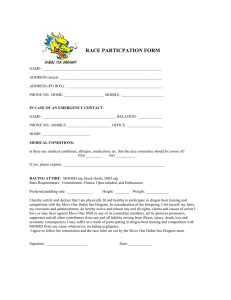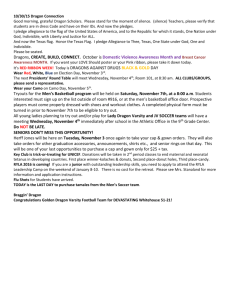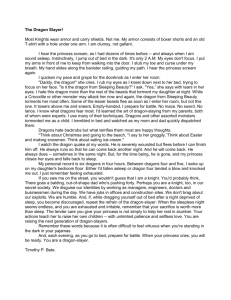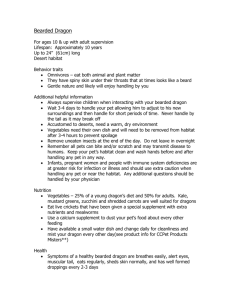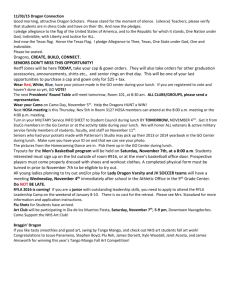www.davesdragons.com Bearded Dragon Care Sheet Temperature
advertisement
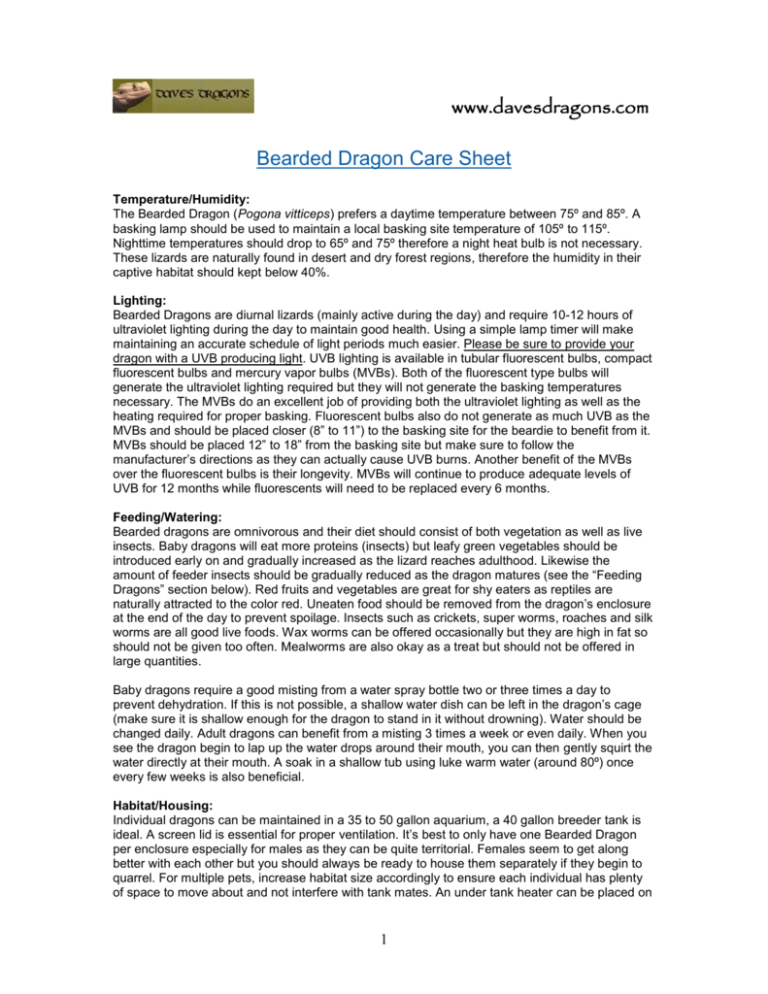
www.davesdragons.com Bearded Dragon Care Sheet Temperature/Humidity: The Bearded Dragon (Pogona vitticeps) prefers a daytime temperature between 75º and 85º. A basking lamp should be used to maintain a local basking site temperature of 105º to 115º. Nighttime temperatures should drop to 65º and 75º therefore a night heat bulb is not necessary. These lizards are naturally found in desert and dry forest regions, therefore the humidity in their captive habitat should kept below 40%. Lighting: Bearded Dragons are diurnal lizards (mainly active during the day) and require 10-12 hours of ultraviolet lighting during the day to maintain good health. Using a simple lamp timer will make maintaining an accurate schedule of light periods much easier. Please be sure to provide your dragon with a UVB producing light. UVB lighting is available in tubular fluorescent bulbs, compact fluorescent bulbs and mercury vapor bulbs (MVBs). Both of the fluorescent type bulbs will generate the ultraviolet lighting required but they will not generate the basking temperatures necessary. The MVBs do an excellent job of providing both the ultraviolet lighting as well as the heating required for proper basking. Fluorescent bulbs also do not generate as much UVB as the MVBs and should be placed closer (8” to 11”) to the basking site for the beardie to benefit from it. MVBs should be placed 12” to 18” from the basking site but make sure to follow the manufacturer’s directions as they can actually cause UVB burns. Another benefit of the MVBs over the fluorescent bulbs is their longevity. MVBs will continue to produce adequate levels of UVB for 12 months while fluorescents will need to be replaced every 6 months. Feeding/Watering: Bearded dragons are omnivorous and their diet should consist of both vegetation as well as live insects. Baby dragons will eat more proteins (insects) but leafy green vegetables should be introduced early on and gradually increased as the lizard reaches adulthood. Likewise the amount of feeder insects should be gradually reduced as the dragon matures (see the “Feeding Dragons” section below). Red fruits and vegetables are great for shy eaters as reptiles are naturally attracted to the color red. Uneaten food should be removed from the dragon’s enclosure at the end of the day to prevent spoilage. Insects such as crickets, super worms, roaches and silk worms are all good live foods. Wax worms can be offered occasionally but they are high in fat so should not be given too often. Mealworms are also okay as a treat but should not be offered in large quantities. Baby dragons require a good misting from a water spray bottle two or three times a day to prevent dehydration. If this is not possible, a shallow water dish can be left in the dragon’s cage (make sure it is shallow enough for the dragon to stand in it without drowning). Water should be changed daily. Adult dragons can benefit from a misting 3 times a week or even daily. When you see the dragon begin to lap up the water drops around their mouth, you can then gently squirt the water directly at their mouth. A soak in a shallow tub using luke warm water (around 80º) once every few weeks is also beneficial. Habitat/Housing: Individual dragons can be maintained in a 35 to 50 gallon aquarium, a 40 gallon breeder tank is ideal. A screen lid is essential for proper ventilation. It’s best to only have one Bearded Dragon per enclosure especially for males as they can be quite territorial. Females seem to get along better with each other but you should always be ready to house them separately if they begin to quarrel. For multiple pets, increase habitat size accordingly to ensure each individual has plenty of space to move about and not interfere with tank mates. An under tank heater can be placed on 1 the same end of the tank as the basking lamp if you live in a cooler climate. A shelter for hiding is a good idea, especially if multiple pets are in the same enclosure. Substrate (Bedding): For baby dragons, simply line the bottom of the cage with clean newspaper or paper towels and replace as needed. As the dragon gets bigger (6 to 8 months) you can switch to a more natural substrate such as an inert sand. If concerned about impaction, you could use reptile carpet, newspaper or non adhesive shelf liner. FEEDING DRAGONS CAUTION: All Bearded Dragons should be fed insects that are no bigger than the distance between the dragon’s eyes. Hatchlings to three months Two-to-three week old crickets (1/4 inch) should be offered 2 - 3 times a day. Offer only what the animal can eat at one feeding which is usually anywhere from 10 to 30 crickets. The crickets should be dusted with a calcium supplement once a day. Every day offer a small amount of finely chopped greens. Do NOT feed large insects to small dragons, they may get "partial paralysis with hind leg extension." You should also offer a vitamin supplement once a week. Three months to six months Three to four week old crickets (1/2 inch) should be offered twice a day. Insects should be dusted one feeding every day. Offer a dish of finely chopped greens (mustard greens, collards, romaine) every day. You should also offer a vitamin supplement once a week. Six months to one year Four to five week old crickets (3/4 to 1 inch) should be offered once every other day. Insects should be calcium dusted every other day. Offer chopped greens every day and you should also offer a vitamin supplement once a week. Adults Adults should be offered four to six week old crickets 2 - 3 times weekly. Insects should be calcium dusted two feedings a week. Offer chopped greens and mixed vegetables every day. You should also offer a vitamin supplement once a week. During the breeding season, females should be offered a high quality diet rich in calcium and vitamin D3. Following egg-laying you can offer pinky mice 1 – 2 times a week. It is critical that you feed all food insects on a quality diet, and to provide vitamin/mineral supplements. Inadequate diet and supplementation are the primary causes of rearing problems and high mortality rates among juveniles. Make sure to use a good calcium supplement such as Repashy Calcium-Plus which contains the correct amount of calcium, vitamin D3 and other necessary vitamins to be given with regular feedings. If using only a calcium with D3 supplement such as Rep-cal w/D3 you should also include a vitamin supplement such as Rep-Cal’s Herptivite contains Beta at most once a week. Some vitamins can be toxic if given too often. Dusting insects is easily accomplished by placing a small amount of supplement dust into a jar or plastic bag. Drop the insects in and gently shake the container till they are coated. Lack of vitamin D3 and calcium, as well as wrong calcium to phosphorus ratio (should be 2:1), may cause leg twitching, shakes, and partial paralysis. It is recommended that you NOT feed insects you have caught in your house or yard, these may have come in contact with any number of poisons and remember... your dragon is what he eats 2 Dragon safe foods Bell Pepper Blackberries Blueberries Butter worms Cantaloupe Chicory Cilantro Collard Greens Cricket Dandelion Greens Endive Escarole Grapes Hibiscus Kale Lettuce, Romaine Mango Mealworm Mustard Greens Okra Phoenix Worms Radicchio Raspberries Silkworm Strawberries Super worms Turnip Greens Wax Worms Zophobas Worms Health Issues Calcium Deficiency The first symptoms of calcium deficiency in juvenile bearded dragons is twitching otherwise known as the shakes. Other symptoms are soft jawbones and other neurological problems. To treat, increase the calcium supplement, and expose the bearded dragon to at least 30 minutes of sunlight daily. Coccidia These protozoa is more likely if bearded dragons are kept with other lizard species. Bearded dragons will show signs of losing weight, loose and runny smelly stools. The only way to confirm is to have its stool examined by a veterinarian. Egg-binding Factors that lead to egg binding include weakness from illness, dietary factors (calcium deficiency), low weight, obesity, and improper egg-laying site. You should diagnose the underlying cause and correct. A veterinarian may also administer vasotocin to induce egg-laying. In some cases a veterinarian will perform surgery to remove the eggs and save the animals life. Gastroentric Infections If your bearded dragon shows a loss of appetite, weight loss, and listless behavior, accompanied by loose, discolored, and smelly stools, have a fecal exam done as soon as possible. Successful treatment is likely if veterinary help is sought quickly. Partial Paralysis associated with Hind Leg Extension. Spastic hind leg extension may be caused by feeding large prey items to small bearded dragons. This will happen the following day after the feeding. In most cases the bearded dragon will die. Large prey items appear to affect the nervous system (spinal nerves). It maybe the prey item pushes against the spinal cord. Respiratory Infections Prolonged exposure to temperatures that are marginally cool can result in respiratory infections. The most obvious symptoms are gaping, forced exhalation of air, puffing of throat, and a puffed up appearance of the body. In severe cases, mucus will accumulate in the mouth and may emerge from the nostrils. Keeping the bearded dragons at a daytime temperature in the upper 80's to low 90's F, will allow them to fight off the infections. If symptoms persist, take the bearded dragon to a veterinarian to be injected with antibiotics. Be careful to not mistake the normal gaping behavior bearded dragons do when overheated. 3
